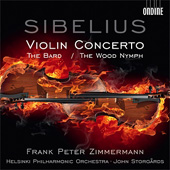

At the time when this wonderful Violin Concerto in D minor, Op. 47 was written,
Jean Sibelius (1865-1957) was, according to biographical accounts, going through
some personal emotional turmoil and alcohol abuse. Add to that the many feverish mood swings he went through struggling with the abundance of musical material
spinning in his head, and it's surprising he finished it. I suppose the fact that he himself had dreamed of becoming a violin virtuoso helped in the process.
Like a lone voice in the wilderness, the violin itself begins the concerto (Sibelius believed it was boring to watch the soloist standing there waiting for his or her
entrance, and I myself have always thought that it must actually be embarrassing for the violinist to be standing there, exposed, doing nothing, until its time to play)
and Frank Peter Zimmermann immediately casts a darkish tone to the work with a probing line and emotionally rich and sombre violin sound. Given
the fact that Sibelius was primarily a symphonist, the orchestra's role in this concerto is just as important as the soloist's and sometimes seems to take over in the early
stages of the first movement, but at the 6:35 mark the violin returns with anguished cries of despair projected with the utmost power and beauty of tone in the high notes
by Zimmermann. I've rarely heard this done so well. In the following Adagio di molto movement, Zimmermann's dark and burnished tone makes his
instrument sound more like a viola which suits the music perfectly as it helps emphasize its deep melancholy. The whole movement is beautifully captured by both the
orchestra and the soloist in this recording, and even more so at the end when Zimmermann manages to produce an almost sobbing effect from his violin. The final
movement takes off like a tall ship with full sails catching the wind. Sibelius had made it quite clear that this movement was to be played at the metronome marking of
108-116, if the virtuoso character within it was to reveal itself, and in this recording, the opening tempo is exactly 116. Others have recorded it slower which robs the
music of its intended character. I myself find that the middle section's rhythm sounds Spanish to me. Somewhat like a flamenco dancer caught up in a very passionate
moment. All of this passion and energy is very well projected by Frank Peter Zimmermann and conductor John Storgards. The
final few bars are almost on fire. This is Zimmermann's first recording for Ondine. Hopefully it's not the last.
The CD also includes two symphonic poems. The Bard, Op. 64 and The Wood Nymph (Skogsraet), Op. 15. Neither are very well
known or have seen many recordings. According to the booklet notes, The Bard was composed when Sibelius was recovering from throat surgery, and was abstaining
from alcohol and smoking cigars, and concentrating on his internal voices. It is a beautiful work with many inspired harp passages, and very well performed in this
recording. The Wood Nymph, at 24 minutes, is almost as long as the violin concerto, and just as dramatic. Although a bit repetitive at times, it definitely has a Wagnerian
scope to it, all the more emphasized by fine brass choir writing. After an impressive brass laden opening, and segments depicting wind rushing through the woods,
its central section is a marvel of rich cello melodies until the march motif returns, this time infused with a sense of tragedy, and inexorably crescendos and builds in
tension until the very end. Again, all of this drama and orchestral colors very well captured by the Helsinki Philharmonic Orchestra, which, after all,
is the orchestra that premiered these works 100 years ago under Sibelius himself.
The Ondine recording itself, a 24-bit recording in DXD (Digital eXtreme Definition), is excellent and does a great job at reproducing the full dynamic
range of the music and gets the balance between the violin and orchestra just right. There already are many fine interpretations of this iconic violin concerto, and this
new recording jumps right up to the top ranks.
Jean-Yves Duperron - August 2010